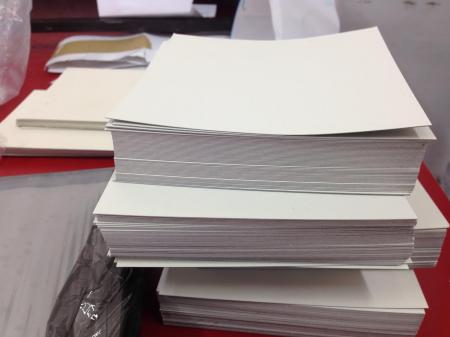How to avoid curling in duplexing
In my experience we’ve tried several adhesives, and used the same brand for a couple years now, it seems that sometimes their batch is just more helpful than other times.
We’ve had periods of perfectly flat duplexing and then periods where everything just wants to curl up.
I want to know what your advice would be on how to get a perfect flat duplexing every time.
Thank you in advance for any tips or suggestions.

duplex.jpg
At a guess, I’d say it’s more likely the paper than the glue. Quite likely there’s some slight difference in the two sheets so one absorbs slightly more moisture from the glue and swells more. As a related question, how are you drying your sheets? Are you pressing them flat in a bookpress or similar or just air-drying? That could also affect curl.
—
Michael Hurley
Titivilus Press
Memphis, TN
We use a Pot Devin, we dial in the thinnest layer of glue to be able to paste them.
That photo is actually the same paper. What intrigues me is that we’ve had some periods with no curling, even with different stocks.
We put them under a heavy weight for a day or overnight.
Mounting on many different substrates is what we do every day. Sometimes you can’t get rid of a curl. However, by flipping your stock one way and then the other and putting under weight over night really helps. Another thing you can try is have the paper grain go two different directions. Many of our customers often send pieces printed that way so that when they are mounted the grains oppose each other. This also can greatly reduce the curl.
i have found some water based adhesives will curl. solvent based, i have much better luck. Offsetting paper grain is a must.
Thanks Kellypress, I will try those suggestions.
Ericm, what type of solvent glue are we talking about? Is it used on a Pot Devin?
Thank you!
It used to be in Europe generally, and maybe still is that Mills despatched pallets of paper seasoned in their storage to a constant condition of stability in a print shop with 65% Relative Humidity at 65 degrees of temperature. Not so
for despatches to hot countries North Africa etc etc. It may
be that US mills. follow something similar, perhaps with exceptions for Southern states. The mills sell a lot of water in fact, and don’t tell printers, who almost never really understand what RH really means. Now last weeks delivery was laying in your shop over maybe some dryer days, and the laminate came in yesterday … get the point?
Remedy get both into small stacks overnight even several days and nights, and let them get together as it were.